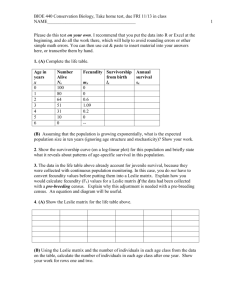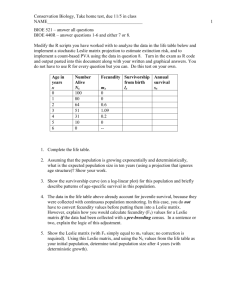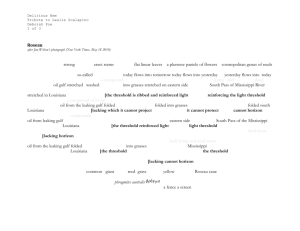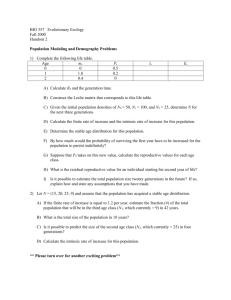Laura+Hinton3 - LeslieScalapinoTribute
advertisement
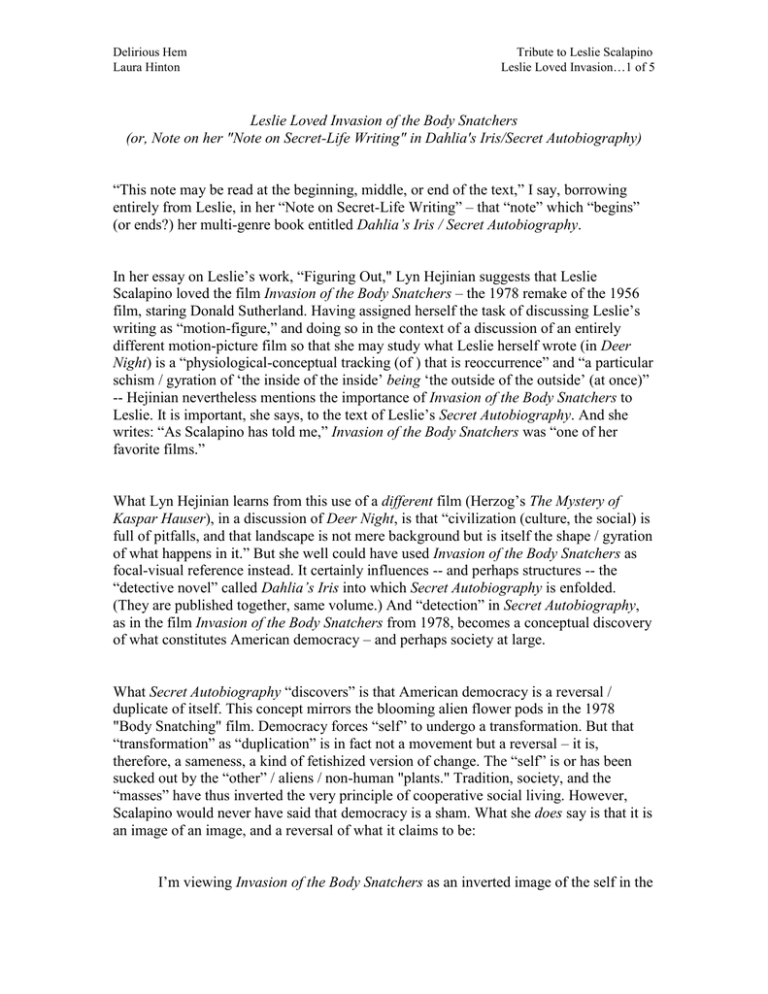
Delirious Hem Laura Hinton Tribute to Leslie Scalapino Leslie Loved Invasion…1 of 5 Leslie Loved Invasion of the Body Snatchers (or, Note on her "Note on Secret-Life Writing" in Dahlia's Iris/Secret Autobiography) “This note may be read at the beginning, middle, or end of the text,” I say, borrowing entirely from Leslie, in her “Note on Secret-Life Writing” – that “note” which “begins” (or ends?) her multi-genre book entitled Dahlia’s Iris / Secret Autobiography. In her essay on Leslie’s work, “Figuring Out," Lyn Hejinian suggests that Leslie Scalapino loved the film Invasion of the Body Snatchers – the 1978 remake of the 1956 film, staring Donald Sutherland. Having assigned herself the task of discussing Leslie’s writing as “motion-figure,” and doing so in the context of a discussion of an entirely different motion-picture film so that she may study what Leslie herself wrote (in Deer Night) is a “physiological-conceptual tracking (of ) that is reoccurrence” and “a particular schism / gyration of ‘the inside of the inside’ being ‘the outside of the outside’ (at once)” -- Hejinian nevertheless mentions the importance of Invasion of the Body Snatchers to Leslie. It is important, she says, to the text of Leslie’s Secret Autobiography. And she writes: “As Scalapino has told me,” Invasion of the Body Snatchers was “one of her favorite films.” What Lyn Hejinian learns from this use of a different film (Herzog’s The Mystery of Kaspar Hauser), in a discussion of Deer Night, is that “civilization (culture, the social) is full of pitfalls, and that landscape is not mere background but is itself the shape / gyration of what happens in it.” But she well could have used Invasion of the Body Snatchers as focal-visual reference instead. It certainly influences -- and perhaps structures -- the “detective novel” called Dahlia’s Iris into which Secret Autobiography is enfolded. (They are published together, same volume.) And “detection” in Secret Autobiography, as in the film Invasion of the Body Snatchers from 1978, becomes a conceptual discovery of what constitutes American democracy – and perhaps society at large. What Secret Autobiography “discovers” is that American democracy is a reversal / duplicate of itself. This concept mirrors the blooming alien flower pods in the 1978 "Body Snatching" film. Democracy forces “self” to undergo a transformation. But that “transformation” as “duplication” is in fact not a movement but a reversal – it is, therefore, a sameness, a kind of fetishized version of change. The “self” is or has been sucked out by the “other” / aliens / non-human "plants." Tradition, society, and the “masses” have thus inverted the very principle of cooperative social living. However, Scalapino would never have said that democracy is a sham. What she does say is that it is an image of an image, and a reversal of what it claims to be: I’m viewing Invasion of the Body Snatchers as an inverted image of the self in the Delirious Hem Laura Hinton Tribute to Leslie Scalapino Leslie Loved Invasion…2 of 5 U.S. (the self as an ‘original appearance only,’ limited and fixed, which continues to appear the same by being utterly destroyed as duplication). (16) In her “Note,” Scalapino then critiques the idea that movement, or “transformation,” is in of itself radical – and perhaps that the so-called mobile “freedom” allowed by democracy is in fact a duplication effect that absorbs any authentic being – like so many flower pods. We recall that this is what happens in the film. While the film’s narrative action is set in the streets, homes, and bureaucracies of San Francisco, it is an “alien nature” that invades. In the 1956 black-and-white film, also a fascinating movie, the “pods” are not clearly plants but identified with an alien “sea.” In the 1978 film, however, the pods are clearly natural organisms that grow and “invade” their now-urban surroundings – and humans – with plant-like filaments and tentacles that attach to the subject / human they wish to absorb and then colonize, destroy. This “nature” therefore may transform but it also destroys the “original” body, which becomes a displacement, a simulacrum – one devoid of human emotion, feeling, mind, and spiritual will. Donald Sutherland in the 1978 film As in the 1956 movie, there is of course the requisite Hollywood heterosexual “love interest” in the 1978 version that Leslie apparently favored. The protagonist is a man in love with a distant – but soon to become (temporarily) “close” – woman. Then, her body is invaded, “snatched,” because (in both versions) the man steps away from her – however momentarily and in order to protect her from the Snatchers. He fails in his job as male protector and bodyguard, fails in his role as knight errant defending the “weakness” of “natural” femininity. And when she becomes the robotic “snatcher” herself, this male protagonist immediately repudiates “her.” But was she ever "her"? And did the claustrophobic male ever want the female tentacles to sink in to his skin to begin with? In both movies, “she” is the alien nature signifying danger to man. "She" threatens – like all the Body Snatchers – to invade and absorb his masculine reference, his male prowess. Delirious Hem Laura Hinton Tribute to Leslie Scalapino Leslie Loved Invasion…3 of 5 Chase scene in the 1956 film Before she is “snatched” away from their utopian relationship and its love scenes, there are many "chase" scenes: snatched bodies chasing the would-be snatched (but still “free”) souls. These chase scenes occur in both films. But the chase scenes in the 1978 film are visually very well executed, meant to be “read.” In one sequence, the male protagonist (played by Sutherland) is running with his girlfriend, who is wearing a red slinky shirt and those low ’70’s “pump” heels. She has more trouble running, of course – not only because she is the “weaker female” – her weakness is exacerbated by the difference in the shoes. He is wearing a pair of conventional leather-lace up masculine-attire shoes. The camera level is shot at the level of the feet – emphasizing both her red sexy skirt and the difference in footwear. Sexual difference is further divided by the mass of feet closing in, following. The Body Snatchers are trying, in mass unidentifiable numbers, to catch and colonize the “free” human couple. But are they free – this “couple” of humans? It is the horrific conclusion of the 1978 movie that leaves one most startled. The cold-war paranoia “chase” of the 1956 film has a relatively happy conclusion, when the male protagonist finally finds an “outside” to which he can tell his story – one of invasion fear. He find a small-town American audience and its figures of authority – a sheriff, an M.D. – and these figures finally believe the narrative of his “Truth.” (They themselves visually witness a "pod.") But there is no “truth,” per se, in the 1978 film. We are all in America; we are the invaders. Every law enforcement agency, every city bureaucracy – like the San Francisco mayor’s office and the police force – is in it for the kill. The male protagonist has no chance of surviving the invasion of his masculine body. At this film's ambiguous end, it doesn’t matter whether or not he has been invaded, or is wearing the Body Snatcher’s mask instead. We, his viewing audience, realize that he is doomed like we are: to this world of duplication without thought, of activity without reason, of business-as-usual in the workplace without connection to other humans – we are doomed to lives as he does, without real agency or heart. Going back to Leslie’s “Note” and its larger con-text: there is a ‘secret’ to the “Secret Autobiography,” itself a kind of “secret” – subliminal without being inside, interior, or within a psyche; it is a text that informs the larger context in which it is reproduced, Delirious Hem Laura Hinton Tribute to Leslie Scalapino Leslie Loved Invasion…4 of 5 Dahlia’s Iris as “detective novel” (a form that Scalapino assures us “is not based on realism but on repetition“). And so, too, are the alien flower pods in the second Invasion of the Body Snatchers film “not based on realism but on repetition.” They are the factors of kinesthetic replication, displacement and dissolution. They are the forms of a social structuring that actively evacuates “being” by “duplicating,” and calls this “freedom.” This becomes a statement about U.S. colonial activities, both internal-domestic racism and overseas acts of hegemony and violence. And it all comes down to literature and language, to “writings.” As Leslie notes in her “Note”: In U.S. postcolonialist writings now, opposition to conceptual appropriation of other cultures is sometimes being articulated as: to confine to description of their tradition, not one’s interior practice. (16) “Description of tradition” is the problem, not a solution. It leads to a kind of passiveaggressive flower (pod) war. Everything is an imitation of “real.” Not that there is an original to be had. But one must recognize the language structures of the “real,” nonetheless. In the detective novel proper, Leslie will go on to write: Society is ‘only’ an orchid parasite fostering war. So outside in suffering, ‘no one’ ‘born as anything’ is suffering too. It’s everywhere here also. (57) She will also comment on the power of the pod – the internalized violence this parasitic creature of “nature” evokes: The pod has no other expression ... The people in this process are killed. Introducing the pod-flowers, all the individuals are duplicated as crowd-form (as their individual forms). (56) She also continues to comment on post-colonial structures like that of racism: Everywhere the transformation of others, their individual bodies’ appearance being duplicated ... Nothing outside of the result of the transformation is to exist. Obsession with being “normal.” Racism is the view that one’s appearance is the original. (58) There is no utopian field in Leslie’s writing. If the U.S. is particular in its modeling of Delirious Hem Laura Hinton Tribute to Leslie Scalapino Leslie Loved Invasion…5 of 5 duplication as subordinating act, her “Note” makes it clear that other countries – she mentions Tibet – also encode this current struggle. She writes of Tibet as Quintessentially the modern state by being the inverted image: visibly contains all times, is occupied (by invaders and/or by itself) .... (17) She then concludes by saying: I wrote this after traveling in Tibet. (17) *** As always in Scalapino’s writing, there is no outside-versus-inside – although that binarism finds its fascination in her lyric inversions. There is no outside to the inside “invasion” of colonialism, which is “material occupation” (17), but also structure, a text. I wanted to write about a work of art Leslie loved. This text may be read at the beginning, middle, or end. But we will always be in the middle of reading Leslie’s writing. ________________________________________________________________________ Laura Hinton is the author of Sisyphus My Love (To Record a Dream in a Bathtub) (BlazeVox 2009).

